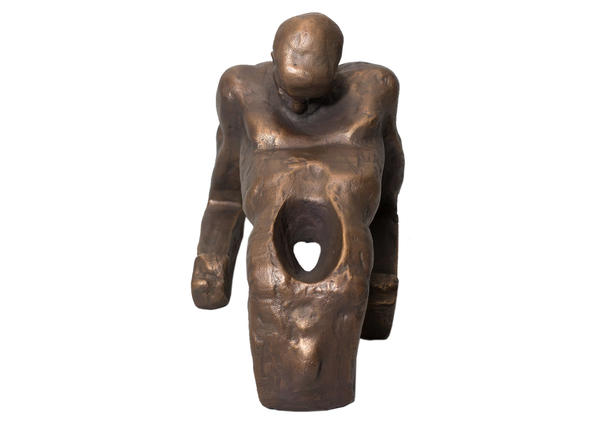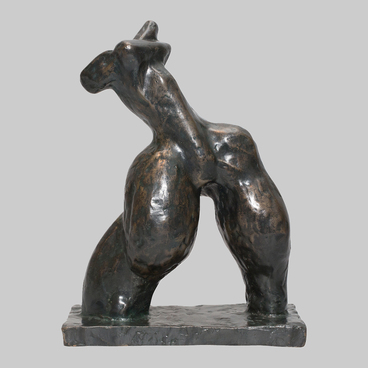The bronze sculpture from the series War is… was created in 1962, at an early stage in the formation of Ernst Neizvestny as an artist. A man who is in a horizontal position, tries to lift himself by leaning on his elbows, but every bend of his body, every vein bulging from under tightened skin, shows how hard any movement is given to him. The torment, suffering, courage and stamina of a wounded man embodied in a piece of metal. In the sculpture Wounded Soldier mental and physical pain is conveyed with maximum expression and incredible realism.
Ernst Iosifovich was a front-line soldier who survived a severe wound at the very end of the war. In August 1942, Neizvestny with a friend and colleague, Yan Sysoev, as volunteers signed up for the front. A seventeen-year-old young man was sent to the border of Afghanistan and Iran, to the city of Kushka, where he was to undergo training at the 1st Turkestan Machine Gun School. Upon graduation in 1943, in the rank of junior lieutenant Ernst Neizvestny was sent to the army, where he fought as a unit commander in the 860th guard’s airborne division.
Ernst Iosifovich was shell-shockd, several times received injuries of varying severity. During the military operations in Austria in April 1945 Neizvestny was wounded, declared dead and posthumously presented to the Order of the Red Star. In the hospital, Ernst, completely bandaged and cast in gypsum, was not responding to external stimuli and was taken to the basement. There the young man was pierced by a sudden pain and he screamed loudly.
After being injured a lifelong disability was predicted for Neizvestny. He spent three years on crutches, with a broken spine, day and night suffering from excruciating pains in his body. Morphine and vodka were his salvation but at some point, Ernst Iosifovich realized that the only effective way to escape from reality and live fully was through work. And completely plunged into creativity.
The Order of the Red Star reached Ernst 25 years later. This story inspired Voznesenski to write “Lieutenant Neizvestny Ernst.” At the same time, Ernst Neizvestny did not like to talk and write about the war. All memories and experiences were reflected in his works. The master used the human body in order to depict those words and feelings that one wants to say out loud. Neizvestny believed that with the help of the human body one can express everything: beauty and ugliness, death and life, joy and sadness, happiness and excruciating pain.
Ernst Iosifovich was a front-line soldier who survived a severe wound at the very end of the war. In August 1942, Neizvestny with a friend and colleague, Yan Sysoev, as volunteers signed up for the front. A seventeen-year-old young man was sent to the border of Afghanistan and Iran, to the city of Kushka, where he was to undergo training at the 1st Turkestan Machine Gun School. Upon graduation in 1943, in the rank of junior lieutenant Ernst Neizvestny was sent to the army, where he fought as a unit commander in the 860th guard’s airborne division.
Ernst Iosifovich was shell-shockd, several times received injuries of varying severity. During the military operations in Austria in April 1945 Neizvestny was wounded, declared dead and posthumously presented to the Order of the Red Star. In the hospital, Ernst, completely bandaged and cast in gypsum, was not responding to external stimuli and was taken to the basement. There the young man was pierced by a sudden pain and he screamed loudly.
After being injured a lifelong disability was predicted for Neizvestny. He spent three years on crutches, with a broken spine, day and night suffering from excruciating pains in his body. Morphine and vodka were his salvation but at some point, Ernst Iosifovich realized that the only effective way to escape from reality and live fully was through work. And completely plunged into creativity.
The Order of the Red Star reached Ernst 25 years later. This story inspired Voznesenski to write “Lieutenant Neizvestny Ernst.” At the same time, Ernst Neizvestny did not like to talk and write about the war. All memories and experiences were reflected in his works. The master used the human body in order to depict those words and feelings that one wants to say out loud. Neizvestny believed that with the help of the human body one can express everything: beauty and ugliness, death and life, joy and sadness, happiness and excruciating pain.




